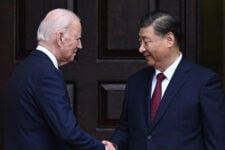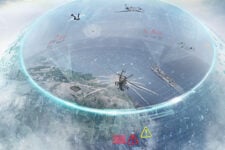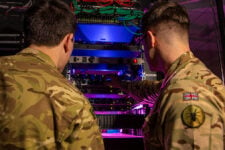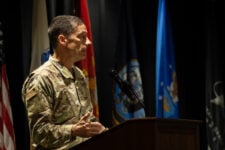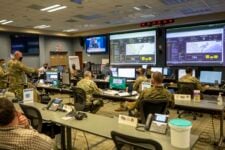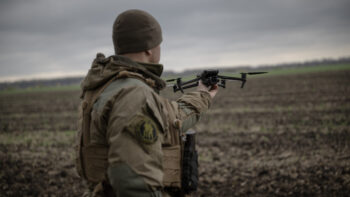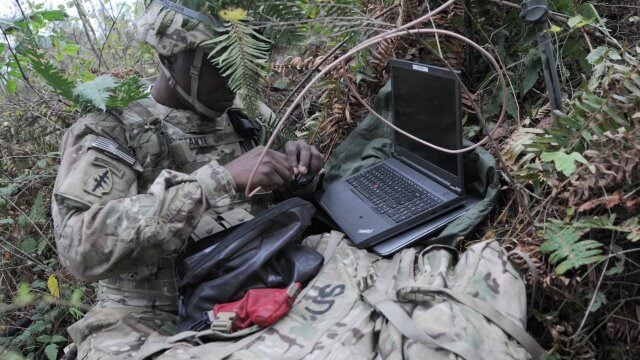
A soldier from the Army’s offensive cyber brigade during an exercise at Fort Lewis, Washington in 2015. (US Army photo)
WASHINGTON — Ukraine has become “the graveyard of command posts,” in the words of one US Army general. In the age of drones, big headquarters are big targets, and Russia in particular has lost general after general to precision strikes.
Now imagine a war between the United States, with its massive Combined Air Operations Centers (CAOCs), and China, whose doctrine of System Destruction Warfare sees such high-tech hubs as pressure points to strike with long-range missiles and cyber attacks.
“You cannot put a hundred people, staff officers and NCOs, into a group of tents and hope that you will not be killed,” said Alexander Kott, an AI expert who worked for DARPA and the Army. “To this day, our command posts look like a bunch of vehicles, a bunch of antennas, a bunch of tents. We know how long this survives on the Russian-Ukrainian front, right? It survives minutes.”
“Western systems today are built in a very hub-and-spoke way,” agreed Sidharth Kaushal, a research fellow at the Royal United Services Institute in London. “Processing happens at central nodes, CAOCs for example, and those systems are inherently fragile — and adversaries have understood this, [hence] systems destruction warfare.”
But AI could make command structures more robust, Kaushal told reporters at a January briefing: “Improvements in processing mean, to a greater and greater extent, key decisions and the processing that underlies them moves to the edge of networks.”
Centralized control and decentralization to the “tactical edge” have different strengths and weaknesses, employ different forms of AI, and above all require different institutional cultures. Those cultural factors might just be America’s enduring advantage in an era when new technology, especially software, spreads rapidly around the globe.
But that’s no cause for complacency for the US. There are other models for modernization than America’s, the Pentagon has its own issues with top-down bureaucracy, and, experts warn, a close reading of Chinese military literature shows at least some officers are calling for more flexibility.
“The Nazis were pretty darn authoritarian, but that didn’t keep them from being innovative when they needed to be,” said Dean Cheng, senior advisor on China at the US Institute of Peace. “They were the ones who invented rockets, assault rifles, and the Blitzkrieg. So this idea that ‘authoritarian equals unable to innovate,’ I think that’s highly ahistorical.”
As far as American innovation goes, Kott, who retired as chief scientist of the the Army Research Lab last year, said he’s “not terribly impressed with what we are doing, unfortunately.”
“We seem to be just building more and more expensive, complicated, and stovepiped communications systems,” he said.
RELATED: Pacific Fleet chief Paparo on China’s big lesson from Ukraine: Win quickly
Meanwhile, like the old Soviet Union — or, for that matter, Germany between the World Wars — authoritarian China has a surprisingly lively discussion of military theory.
“If you look at their writings on what is called ‘informatization,’ they are very much geared towards pushing authority down to the lowest levels,” Kevin Pollpetter, a senior research scientist at CNA, told Breaking Defense. “Whether that will actually happen in practice though is up for debate.”
“At least some PLA writings envision what AI or emerging technologies more broadly could do to empower frontline commanders to make decisions,” agreed RAND researcher Nathan Beauchamp-Mustafaga. “The question is whether these ideas actually carry any weight [with] Chinese military leadership. That’s a really difficult thing to assess from the outside … I think it’s too early to call.”
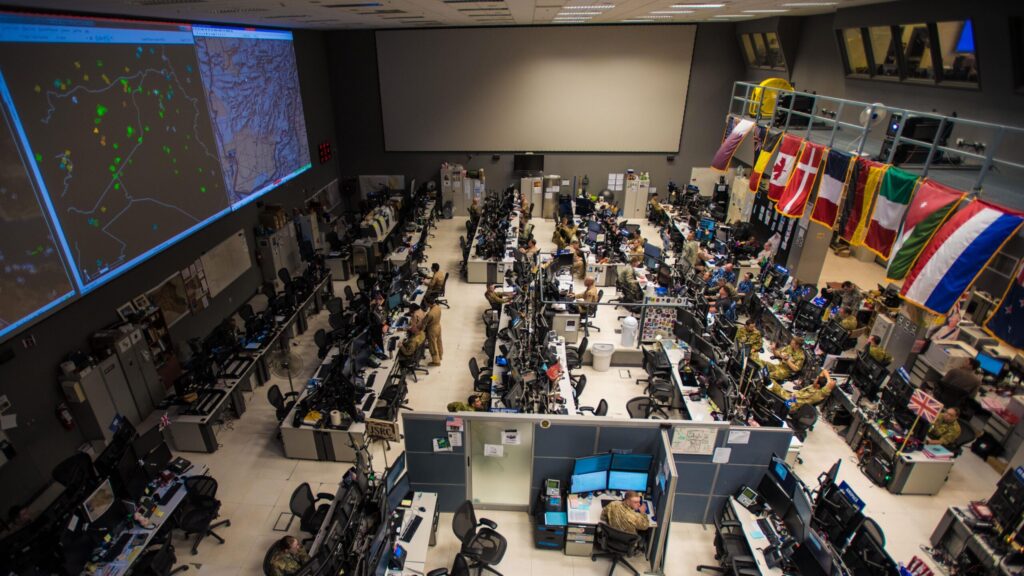
The Combined Air Operations Center (CAOC) at Al Udeid Air Base, Qatar. (US Air Force photo by Staff Sgt. Alexander W. Riedel)
Center Versus Edge
Centralizing control versus empowering the edge isn’t an either-or slam-dunk, but a sliding scale, one militaries move up and down all the time as technology and strategy evolve.
“In reality, it’s always a mix,” Kott said. On the one hand, he told Breaking Defense, “there is a democratization of warfare — [for instance], two soldiers with a drone can do a lot of damage … and so that would be an argument towards decision making moving closer to the edge.”
At the same time, Kott continued, warfare is becoming ever more complex and sprawling. Weapons like long-range missiles and cyber attacks able to converge on a single target from origins thousands of miles apart — if someone can coordinate them. “That has to be done at a higher level,” he said.
Given the power of AI, networks and surveillance technology to bring tremendous data to a single HQ, “there is a perfectly coherent argument [for] the all-empowered theater commander,” agreed Kaushal. “When everything goes right, they can be quite lethal.”
So one option is to use AI to centralize command-and-control still further — to build super-CAOCs with supercomputers, where top commanders and their staffs can algorithmically absorb vast amounts of data from across the war zone to gain a god’s-eye view. Such palatial panopticons are appealing to bureaucracies, but they also exploit some powerful trends in how the technology itself has been evolving.
For example, cloud computing, which the Pentagon has labored to embrace, boils down to a hub-and-spoke structure: A few massive server farms store many users’ data and, increasingly, run their software as well. It’s such hub-and-spoke models that have made power-hungry generative AIs like ChatGPT and DALL-E, which require massive computing power to run, available to millions of people on their laptops and smart phones. A central warehouse full of servers can run AIs too powerful for any one user’s machine, make the most efficient use of scarce technical talent, and reap other economies of scale.
So centralization makes a lot of sense in peacetime. It can even work well in war, coordinating strikes from far-flung forces that would otherwise struggle to act in concert. But as soon as the enemy can strike back, centralization means you have a lot of delicate eggs in one big basket.
“The challenge those structures face is they’re inherently vulnerable to a thinking adversary,” Kaushal told reporters. “When you think of the fundamentals of warfare, going to Clausewitz, that it’s characterized by fog, friction a degree of chaos, it seems more likely than not to me that initiative needs to be pushed to lower levels.”
Even if the HQ itself is a hard target — buried underground, surrounded by missile defenses, or simply so deep in mainland China it’s out of range — it has to talk to targets that aren’t: aircraft, warships, ground units both robotic and unmanned. To get anything done, central command requires hundreds or thousands of connections to its scattered subordinates, both so they can feed it data and it can send them orders. Jam the links, hack them or physically blow them up, and the commander’s god’s-eye-view of the war zone goes deaf and blind.
That’s the essence of the PLA’s “systems destruction warfare” doctrine, said Cheng: “break the connections, whether it’s data links or radio coms or what have you. It can be jamming, … cyber attacks. … It can also be psychological: how much do you trust the coms if every third message is being altered?”
AI can help here, too. “How do you communicate when the battlefield is saturated with jammers?” asked Kott. “Squeezing all the vitamins out of whatever little coms you can get … that’s another role for AI.”
Autonomous algorithms already manage cellular networks, optimizing frequencies and switching calls from one cell tower to the next without the user ever noticing. Military AI could automatically detect when a relay has been jammed, hacked or destroyed and route around it — a souped-up version of what’s called a “self-healing” network. At even higher levels of intelligence, Kott suggested, AI could also throttle usage based on preset priorities, for example by refusing to transmit bandwidth-hogging surveillance video to leave transmission capacity for telegraphic updates on target coordinates.
AI isn’t just helpful at the central hub, however: It is increasingly available and powerful at the edge as well. That dovetails nicely with Starlink putting thousands of communications satellites into Low Earth Orbit, which allows frontline users to communicate without relying on a handful of high-end, high-orbit birds. Advanced analytics firm Royce GEO, for instance, has field-tested using Starlink to download satellite images to portable computers running a slimmed-down version of its object-recognition AI.
“Starlink has been a game-changer,” said Dave Sterling, a former NGA analyst who founded Royce GEO. “It used to be you had to pack a 160-pound antenna that took three men to carry. … All that has changed in a last handful of years. Now we have it down to one person with a laptop and a Starlink on a backpack, [with] a heavy-duty battery pack, who can run machine learning [algorithms] utilizing computer vision from a pickup truck in the harshest environments around the world.”
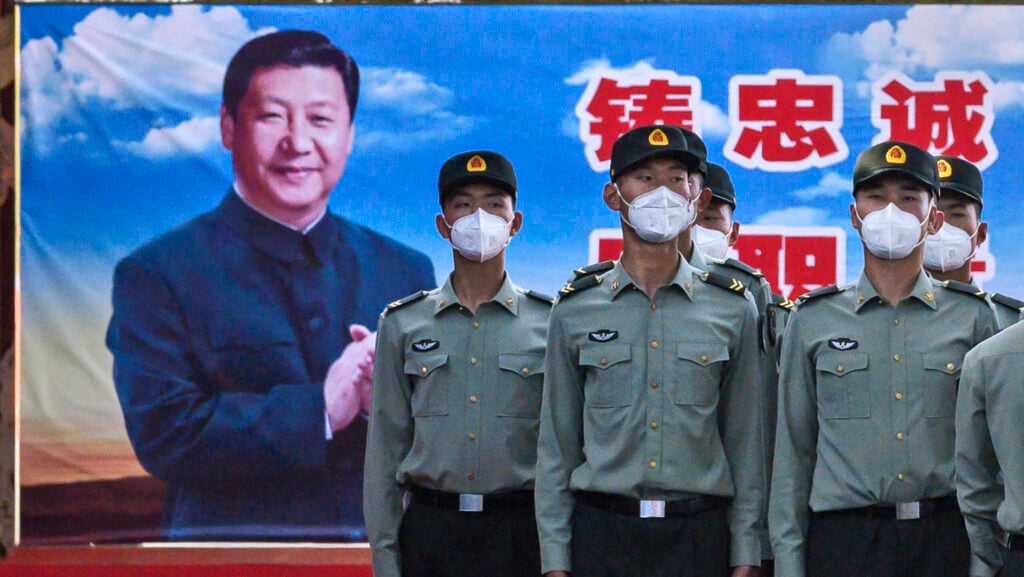
Soldiers of a PLA Honor Guard stand at attention in front of a poster of President Xi Jinping, near Tiananmen Square in Beijing, during the COVID outbreak in 2020. (Photo by Kevin Frayer/Getty Images)
New Tech, New Tactics
Throughout history, from the Bronze Age to the Blitzkrieg, winning commanders have used new technology, not just to fight the old way only better, but to enable entirely new kinds of tactics. Both China and the US, for instance, are exploring AI decision-making aides that can generate “courses of action” — in essence, automating the laborious staff work of tracking supplies, scheduling convoys, coordinating strikes, drafting orders and countless other details that go into a military plan.
“Looking at PLA writings on AI,” said Pollpetter, “a lot of it centers on thinking about AI as sort of a chief of staff, where it’s there in a command post somewhere, you can give it a list of parameters … and then it’ll generate options for the commander — but ultimately it’s the commander that makes those decisions.”
That suggests, said Kaushal, that forward command posts could use AI to plan complex operations without large staffs, giving them the coordinating capability of a large HQ without being a large, slow-moving target.
But will military commanders and, even more important, their political masters allow junior officers to exercise this kind of AI-driven initiative? That’s not an easy sell in Washington, let alone Beijing.
“What people often lose sight of, or maybe don’t realize, is that the PLA is a party army. It is not the country’s army: It is the armed wing of the Chinese Communist Party,” said Pollpeter. “If anything … the political commissar role has been strengthened under Xi Jinping.”
While XI purges top generals, the PLA’s own official self-criticism strikes a strong note of self-doubt. “When you look at their own writing about their soldiers and their officers in particular,” said Kaushal, “[there’s] what they call the ‘Five Incapables,’ the five areas where they feel there are still considerable deficiencies. One of them is the ability of officers lower down the ranks to operate under conditions of uncertainty and fog and friction.”
That lack of confidence in subordinates suggests China’s top leaders will be reluctant to delegate — and that’s a weakness that Western forces can exploit.




